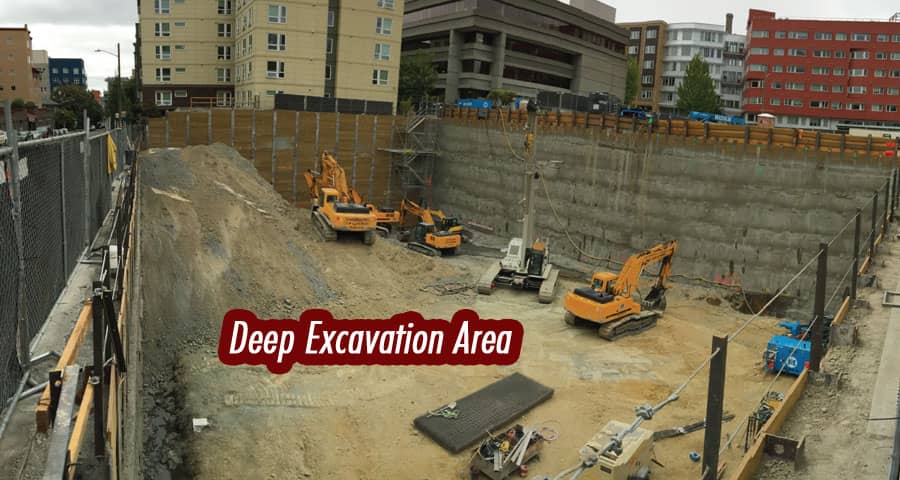How to Work in the Deep Excavation Area?

Introduction
Working in deep excavation areas presents unique challenges and risks that require careful planning and execution. Whether you are a construction professional, engineer, or simply curious about the intricacies of excavations.
Understanding Deep Excavation
Deep excavation refers to the process of digging below the ground surface to create trenches, foundations, basements, or other structures. Such excavations can vary in depth and complexity, ranging from a few feet to several stories deep. Before commencing any excavation project, it is crucial to assess the site conditions, soil characteristics, and potential hazards.
Safety Precautions and Regulations
- Prioritize Safety: Safety should always be the top priority in deep excavation projects. Familiarize yourself with local safety regulations, and ensure all personnel are adequately trained and equipped with the necessary safety gear.
- Risk Assessment: Conduct a comprehensive risk assessment to identify potential hazards, such as cave-ins, equipment accidents, and gas leaks. Develop a safety plan that includes emergency procedures and rescue protocols.
Site Preparation
- Clearing the Area: Before excavation begins, clear the site of any obstructions, utilities, or debris that may impede the work. Mark underground utilities and establish clear boundaries.
- Erosion Control: Implement erosion control measures to prevent soil erosion and sediment runoff, which can have adverse environmental impacts.
Selecting the Right Equipment
- Equipment Selection: Choose the appropriate excavation equipment based on the depth, soil type, and project specifications. Common equipment includes excavators, backhoes, and trenchers.
- Maintenance and Inspection: Regularly inspect and maintain equipment to ensure it operates safely and efficiently. Address any issues promptly to avoid downtime.
Excavation Techniques
- Sloping and Benching: Sloping and benching are techniques used to prevent cave-ins by creating safe angles or steps in the excavation walls. The angle and depth of slopes depend on soil properties.
- Trench Boxes: Trench boxes, or shoring systems, provide additional support to prevent collapses. Proper installation and maintenance are essential.
Shoring and Bracing
- Structural Support: Shoring and bracing systems are critical for stabilizing excavation walls. Engineers design these systems based on soil conditions and depth.
Soil Types and Properties
- Soil Classification: Understanding soil types, such as clay, sand, or gravel, is crucial for determining excavation methods and safety precautions.
- Compaction and Testing: Ensure proper soil compaction and perform soil tests to assess its load-bearing capacity. This information guides excavation planning.
Dealing with Groundwater
- Dewatering: In deep excavations, groundwater can pose a significant challenge. Use dewatering techniques like wellpoints or sump pumps to manage water levels.
- Groundwater Quality: Monitor groundwater quality to prevent contamination and ensure compliance with environmental regulations.
Monitoring and Inspections
- Continuous Monitoring: Regularly inspect excavation walls, support systems, and equipment. Continuous monitoring helps identify potential issues early.
Environmental Considerations
- Environmental Impact: Deep excavations can impact the environment. Implement erosion control measures, manage runoff, and adhere to environmental regulations.
Managing Excavated Material
- Material Handling: Dispose of excavated material responsibly, following local regulations. Consider recycling or reusing materials when possible.
Communication and Coordination
- Team Collaboration: Effective communication among team members is essential for a successful excavation project. Ensure everyone understands their roles and responsibilities.
Emergency Response
- Emergency Protocols: Establish clear emergency response protocols, including evacuation plans and first-aid procedures. Regular drills are essential for readiness.
Case Studies
Explore real-life case studies of deep excavation projects, highlighting challenges, solutions, and lessons learned.
Conclusion
In conclusion, working in deep excavation areas demands meticulous planning, strict adherence to safety regulations, and a deep understanding of soil properties and excavation techniques. By following the guidelines outlined in this article, you can navigate the complexities of deep excavation projects successfully while minimizing risks to personnel and the environment.
FAQs
Is deep excavation always risky?
Deep excavation can be risky, but with proper planning, safety measures, and experienced professionals, these risks can be mitigated.
What equipment is commonly used for deep excavation?
Common equipment includes excavators, backhoes, trenchers, and shoring systems.
How do I manage groundwater in a deep excavation?
Groundwater can be managed through dewatering techniques like wellpoints or sump pumps.
What should I do in case of an emergency during excavation?
Establish clear emergency protocols, including evacuation plans and first-aid procedures, and conduct regular drills.
Are there environmental concerns with deep excavation?
Yes, deep excavation can impact the environment. It's crucial to implement erosion control measures and follow environmental regulations to mitigate these impacts.
